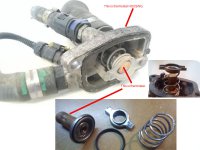- Joined
- Jul 13, 2016
- Messages
- 640
- Points
- 234
Hey guys
This is another one of my more ' just a curiosity' posts. A Bit like the one I posted asked what would happen if u had 4 individual brand of spark plug in.
When needing to test a thermostat, you often read to suspend it in boiling water in a pan. But this only works for for stats that open at around 90 - 98c. For stats that open up at hotter temps 103c - 105c. Could you in theory, have a pan with a 50/50 mix and boil that to allow for a higher boiling point.
I've tried researching this but it's seems to be one of those posts where Google just does not know [emoji3]
This is another one of my more ' just a curiosity' posts. A Bit like the one I posted asked what would happen if u had 4 individual brand of spark plug in.
When needing to test a thermostat, you often read to suspend it in boiling water in a pan. But this only works for for stats that open at around 90 - 98c. For stats that open up at hotter temps 103c - 105c. Could you in theory, have a pan with a 50/50 mix and boil that to allow for a higher boiling point.
I've tried researching this but it's seems to be one of those posts where Google just does not know [emoji3]


